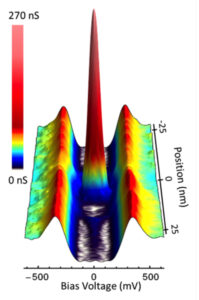Membres
Christophe Brun, Tristan Cren, François Debontridder, Marie Hervé
The new quantum states spectroscopy team has for some years had an important activity around Majorana quasiparticles in topological superconductors. Majorana quasiparticles have half-integer spins, but they have a completely different quantum statistic than fermions, they behave like non-abelian anyons. This property makes these quasiparticles very interesting for the realization of new quantum devices of the qubit type which, according to the theory, are supposed to be much less sensitive to decoherence because a topological protection is at work.
Multiple theoretical works have predicted the existence of topological superconducting phases which would have the property of having Majorana edge states. For example in one dimension the edge states of a topological superconducting wire consist of a pair of bound Majorana states located at the ends of the wire at the Fermi level. In two dimensions, we expect not bound states but dispersive edge states inside the superconducting gap. Moreover, in 2D and 3D, bound Majorana states are expected in the core of vortices or other topological defects such as skyrmions.
In recent years, many works have been done on topological superconducting wires, the first approach is that of Microsoft Research, is to cut semiconductor nanowires to superconductors and apply a magnetic field to generate a topological superconductivity. The other approach is to couple superconductors to magnetic islands. Thus the Princeton team was able to demonstrate zero energy edge states in Fe chains deposited on Pb. We followed a method to fabricate 2D systems consisting of a superconducting Pb atomic plane coupled to PbSi nanomagnets. This system allowed us to demonstrate for the first time the existence of a topological superconductor by imaging its dispersive edge states [1]. We have also shown that this Pb/Co-Si/Si(111) system sometimes exhibits topological defects that manifest themselves by the appearance of a pair of Majorana states at zero energy, one of the states being localized at the center of a Co-Si domain and the other one all around [2]. We are now exploring other systems based on magnetic molecules deposited on superconductors that exhibit the same type of properties.
Key words: topological superconductors, Majoran fermions, topological defects, hybrid superferro systems

Caption: Majorana states measured by scanning tunneling in a Pb/Co-Si/Si(111) island.
Funding
- ANR Superstripes, a theoretical postdoc funded by Dim NanoK
Collaborations
- Pascal Simon’s team University Paris Saclay
- Nadine Witkowski from INSP on Mn phthalocyanines
Publications
1. Gerbold Ménard, Sébastien Guissart, Christophe Brun, Mircea Trif, François Debontridder, et al.. Two-dimensional topological superconductivity in Pb/Co/Si(111). Nature Communications, Nature Publishing Group, 2016, ⟨10.1038/s41467-017-02192-x⟩. ⟨hal-01400191v2⟩
2. Gerbold Ménard, Andrej Mesaros, Christophe Brun, François Debontridder, Dimitri Roditchev, et al.. Isolated pairs of Majorana zero modes in a disordered superconducting lead monolayer. Nature Communications, Nature Publishing Group, 2019, 10 (1), ⟨10.1038/s41467-019-10397-5⟩. ⟨hal-03060026⟩

